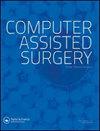颅颌面外科机器人系统的空间标定
IF 1.9
4区 医学
Q3 SURGERY
引用次数: 8
摘要
颅颌面外科的空间配准是将图像空间映射到机器人空间。这需要对多个坐标系进行校准。在此过程中,机器人坐标系与NDI视觉坐标系之间的标定精度直接决定了手术导航系统的精度,是手术成功的关键。本文根据手术的要求,结合视觉系统本身的特点,研究了机器人空间与视觉空间的关系。在此基础上,结合传统方法,提出了一种新的线性旋转标定方法。可自动校准,减少人为误差,提高可靠性和稳定性。最后,通过实验验证了标定算法的有效性。结果表明,最小位置误差小于0.87 mm,最小姿态偏差约0.83度,标定精度满足运行要求。该方法在外科标定中具有良好的应用前景。本文章由计算机程序翻译,如有差异,请以英文原文为准。
Space calibration of the cranial and maxillofacial robotic system in surgery
Abstract Space registration in cranial and maxillofacial surgery is intended to map the image space to the robot space. This requires calibration of multiple coordinate systems. In this process, the calibration accuracy between the robot coordinate system and the NDI vision coordinate system directly determines the precision of the surgical navigation system, which is the key to success. In this paper, the relationship between robot space and visual space is studied according to the requirements of surgery, and with reference to the characteristics of the vision system itself. Based on this analysis and traditional methods, a new linear rotation calibration method is presented. Calibration can be automated to decrease human error and increase the reliability and stability. Finally, an experiment is conducted in order to evaluate the effectiveness of the calibration algorithm. The results show that the minimum position error was less than 0.87 mm and the minimum posture deviation was about 0.83 degrees, indicating that the calibration precision can meet the operation requirements. There are good prospects for this method using in surgical calibration application.
求助全文
通过发布文献求助,成功后即可免费获取论文全文。
去求助
来源期刊

Computer Assisted Surgery
Medicine-Surgery
CiteScore
2.30
自引率
0.00%
发文量
13
审稿时长
10 weeks
期刊介绍:
omputer Assisted Surgery aims to improve patient care by advancing the utilization of computers during treatment; to evaluate the benefits and risks associated with the integration of advanced digital technologies into surgical practice; to disseminate clinical and basic research relevant to stereotactic surgery, minimal access surgery, endoscopy, and surgical robotics; to encourage interdisciplinary collaboration between engineers and physicians in developing new concepts and applications; to educate clinicians about the principles and techniques of computer assisted surgery and therapeutics; and to serve the international scientific community as a medium for the transfer of new information relating to theory, research, and practice in biomedical imaging and the surgical specialties.
The scope of Computer Assisted Surgery encompasses all fields within surgery, as well as biomedical imaging and instrumentation, and digital technology employed as an adjunct to imaging in diagnosis, therapeutics, and surgery. Topics featured include frameless as well as conventional stereotactic procedures, surgery guided by intraoperative ultrasound or magnetic resonance imaging, image guided focused irradiation, robotic surgery, and any therapeutic interventions performed with the use of digital imaging technology.
 求助内容:
求助内容: 应助结果提醒方式:
应助结果提醒方式:


